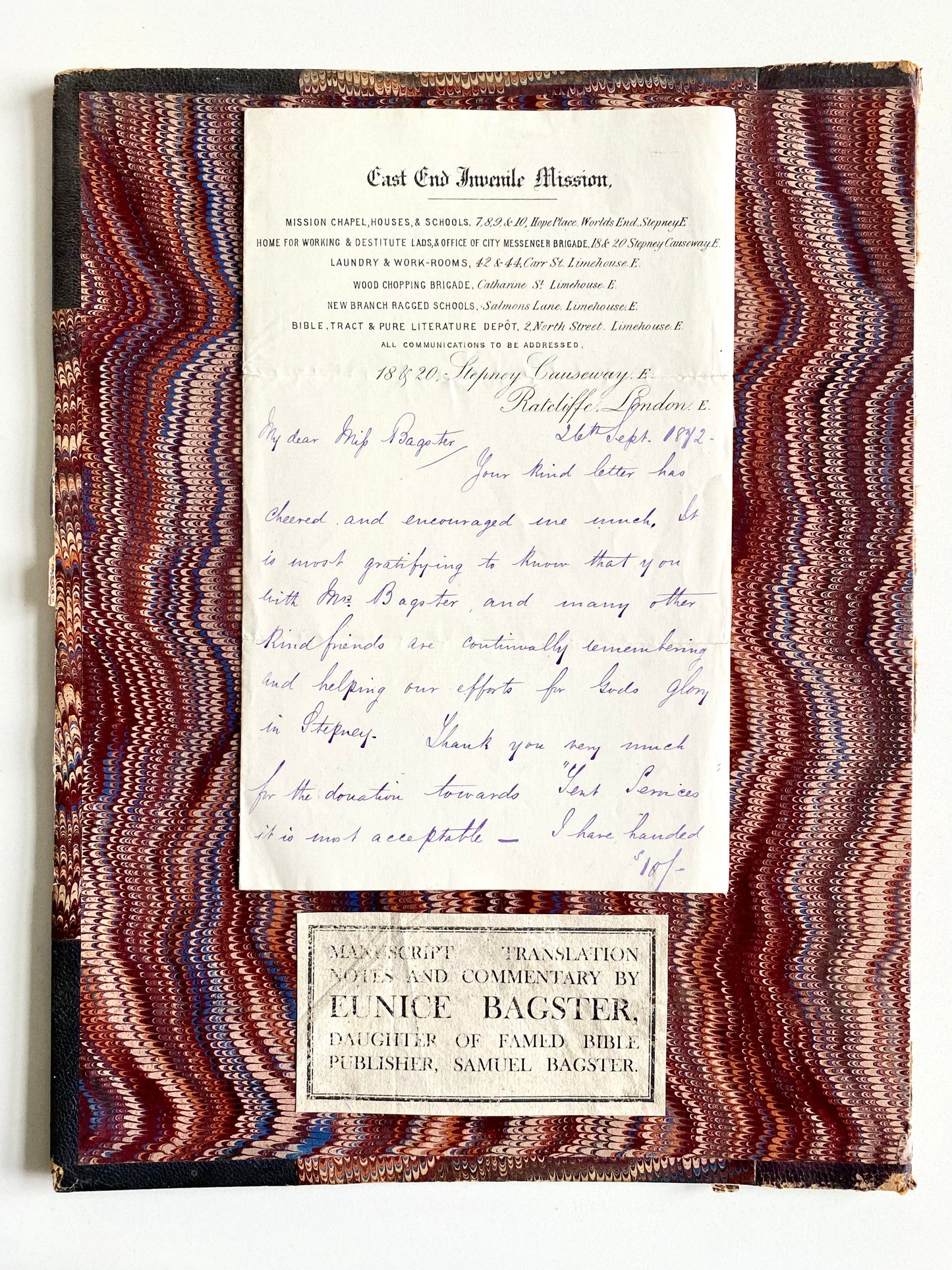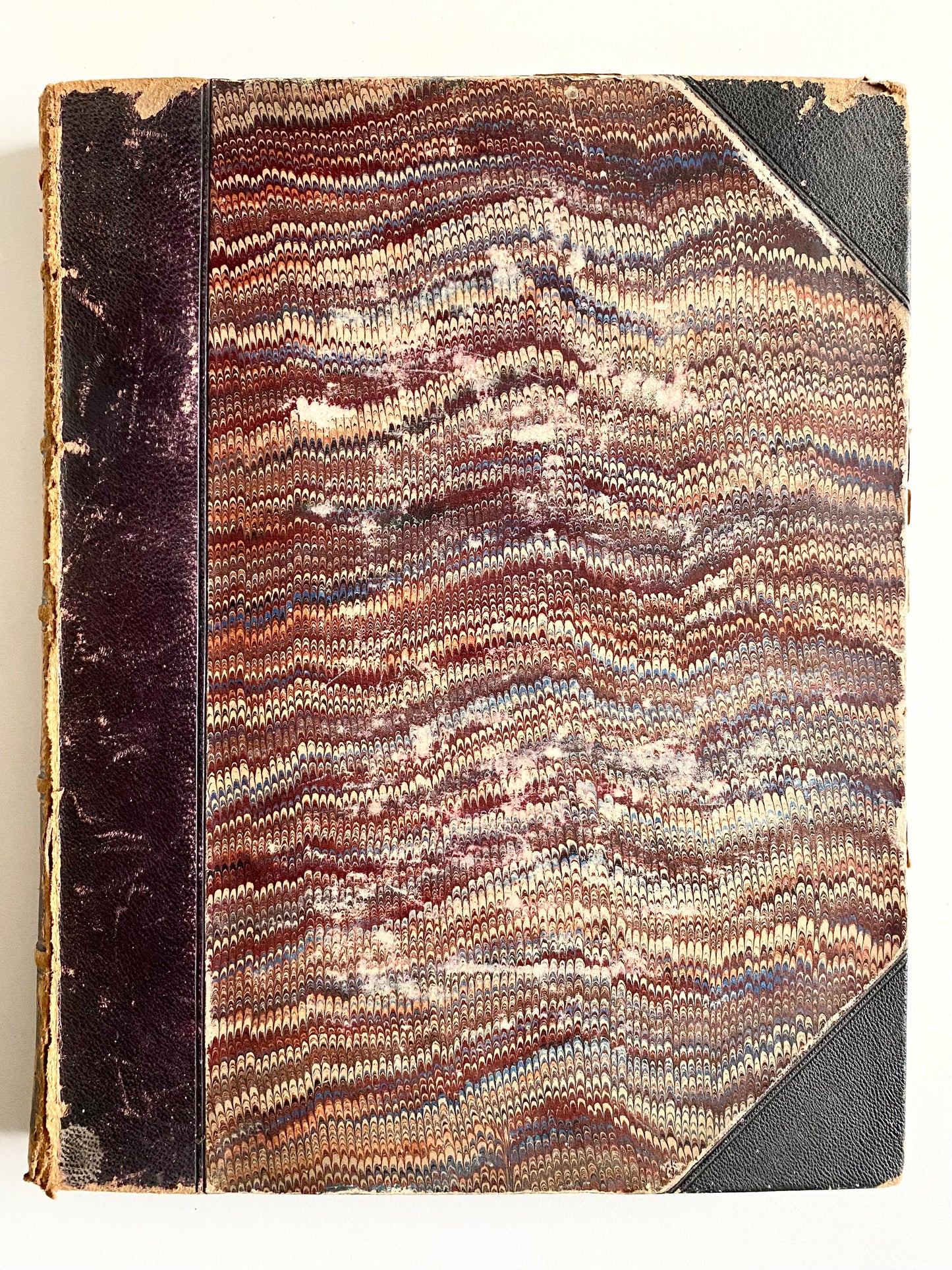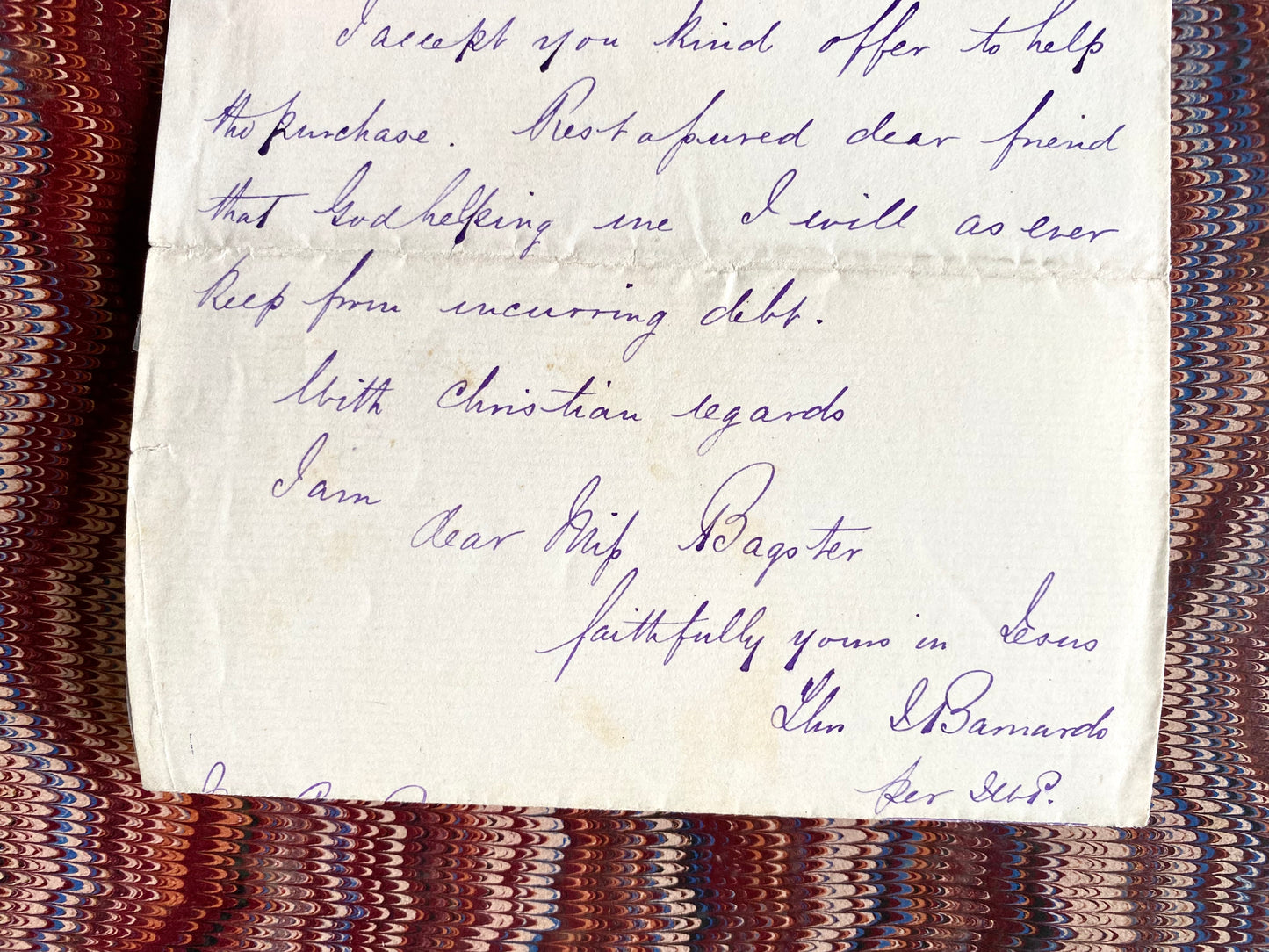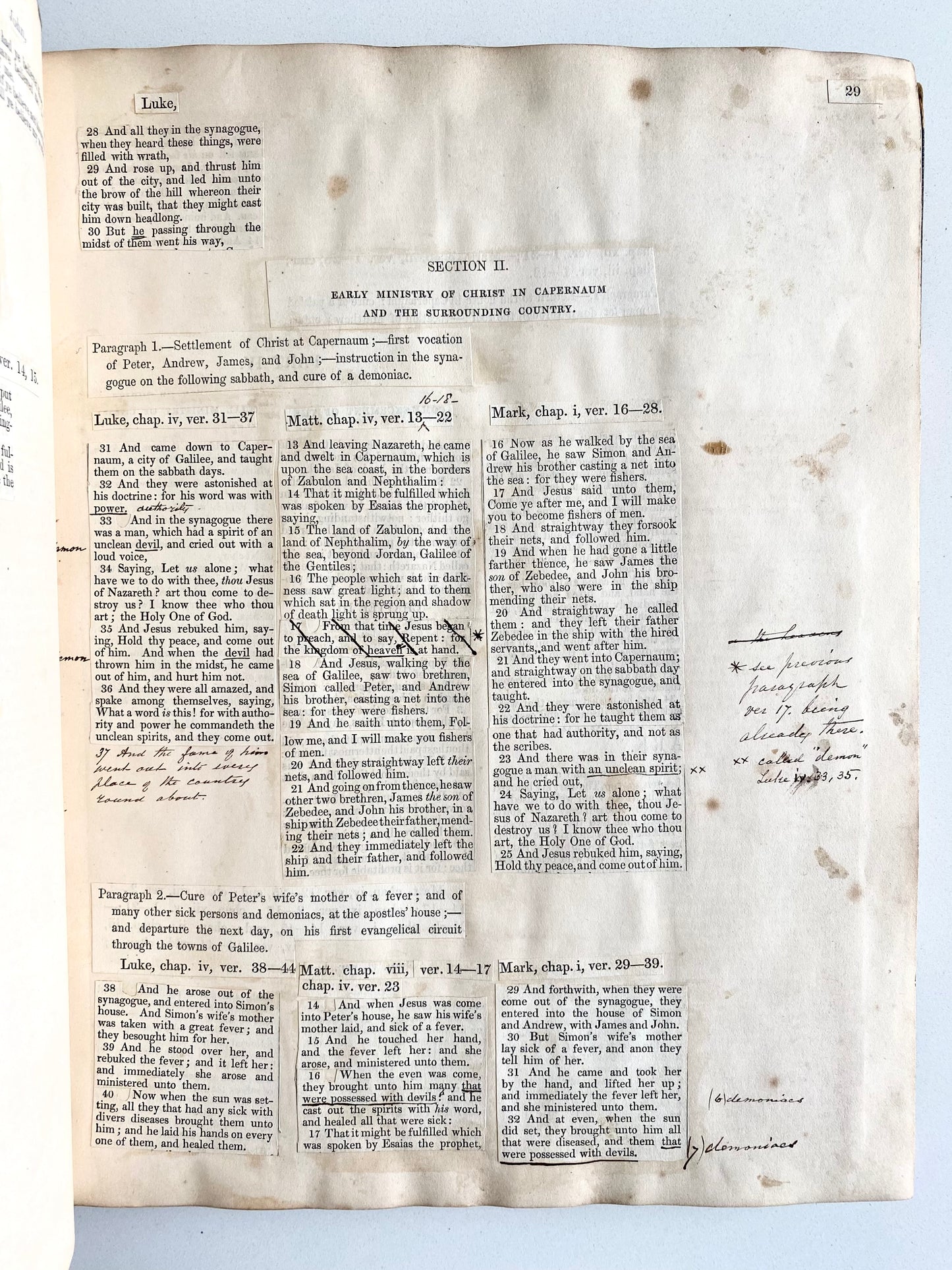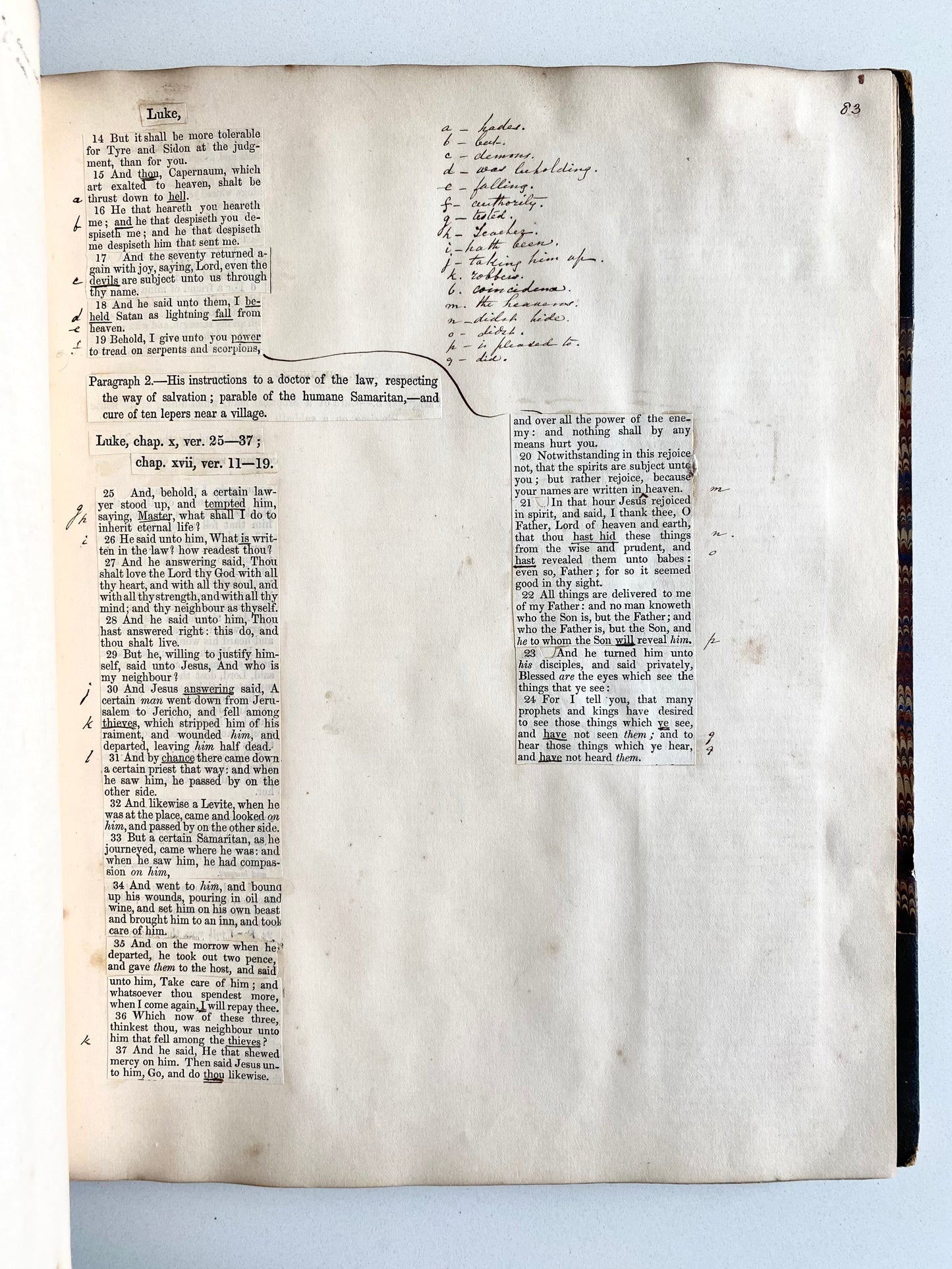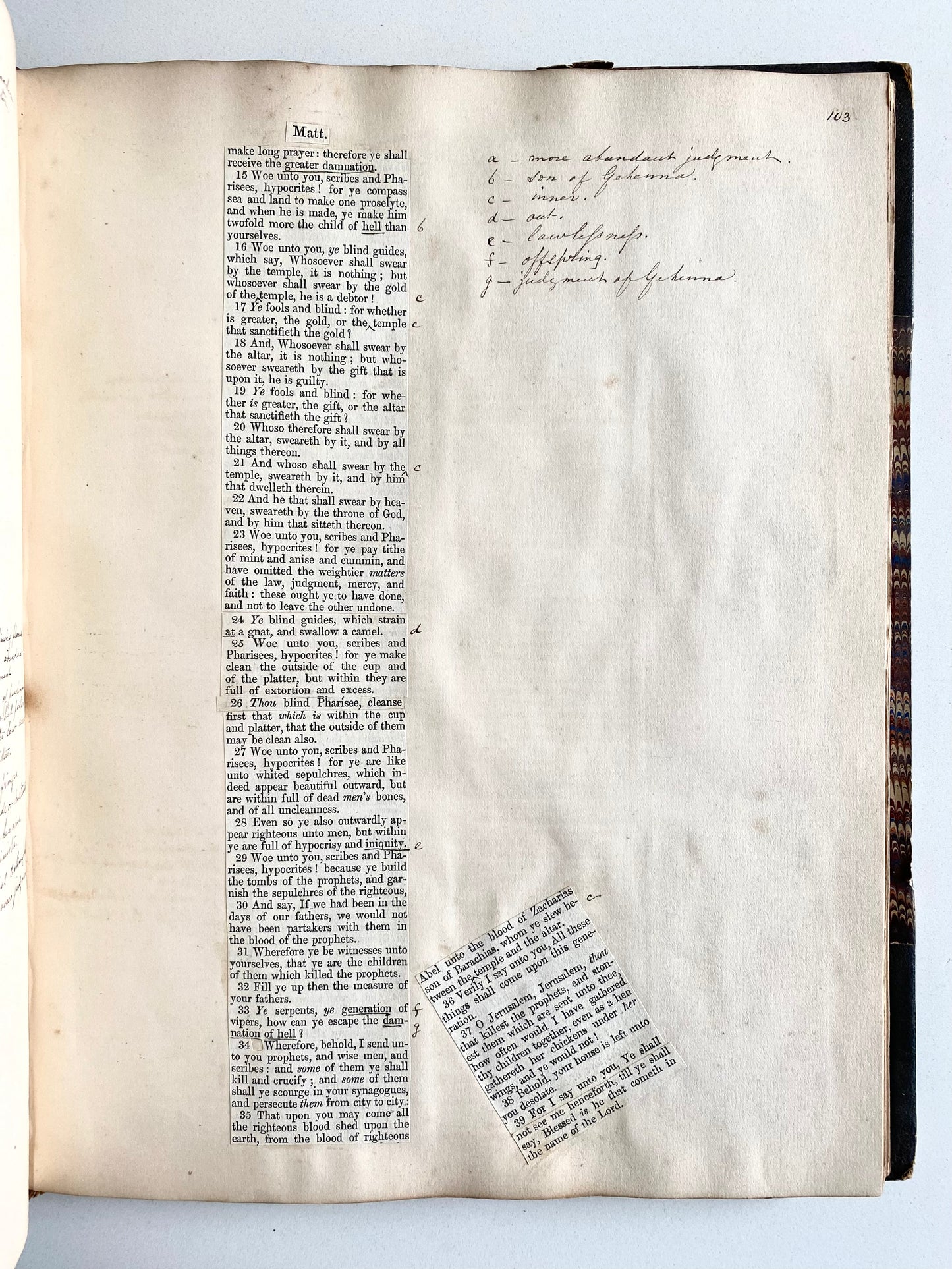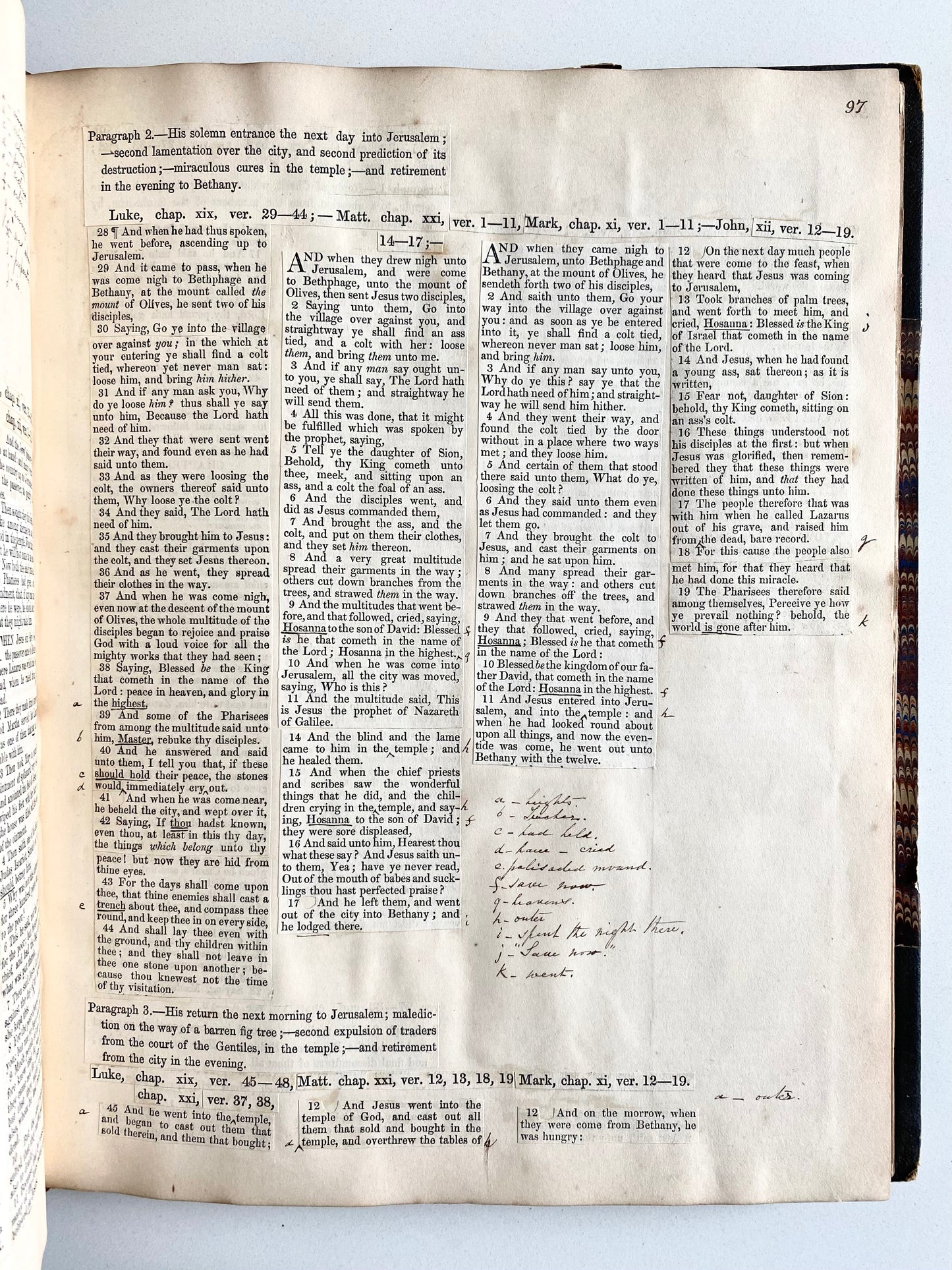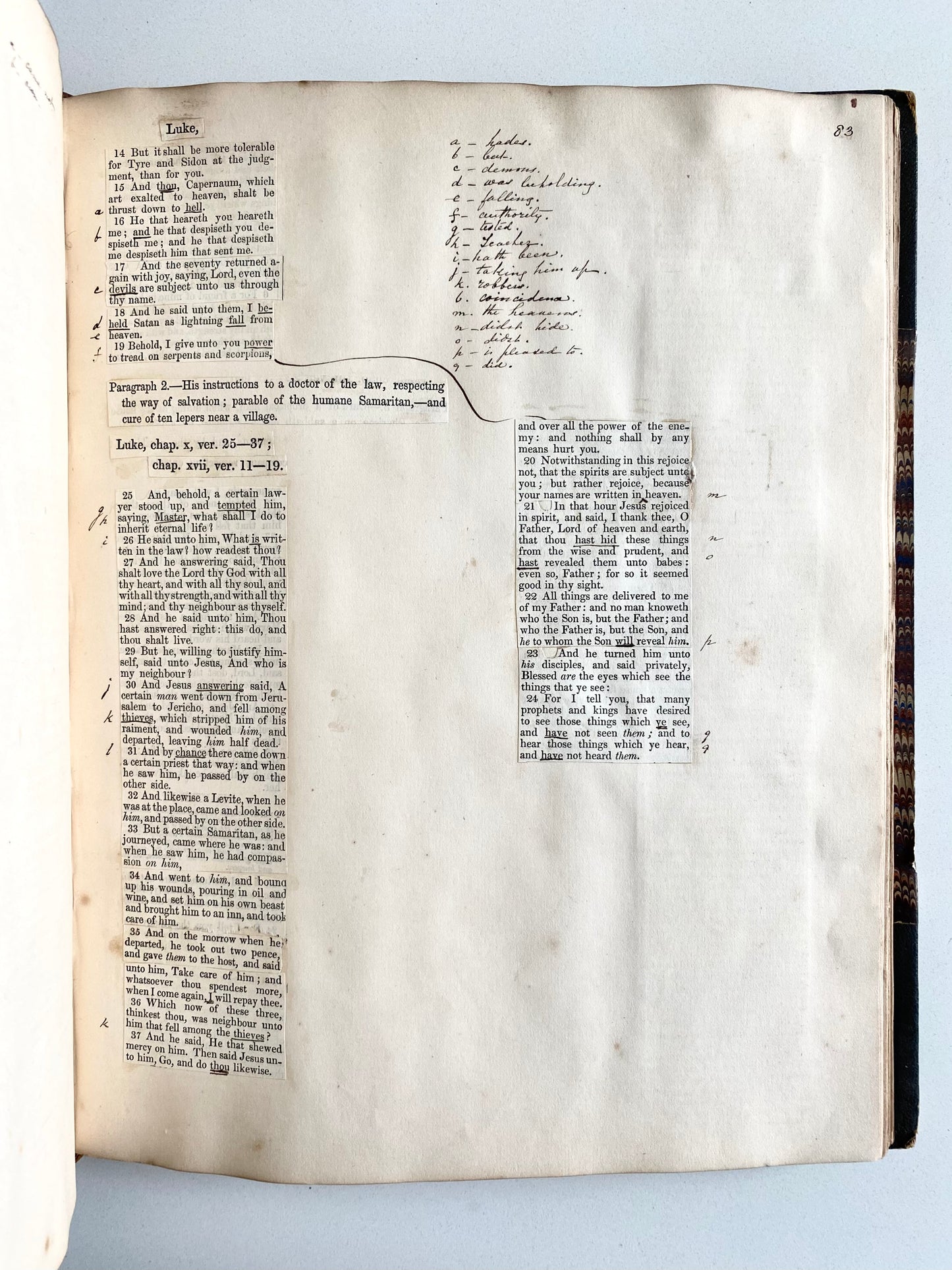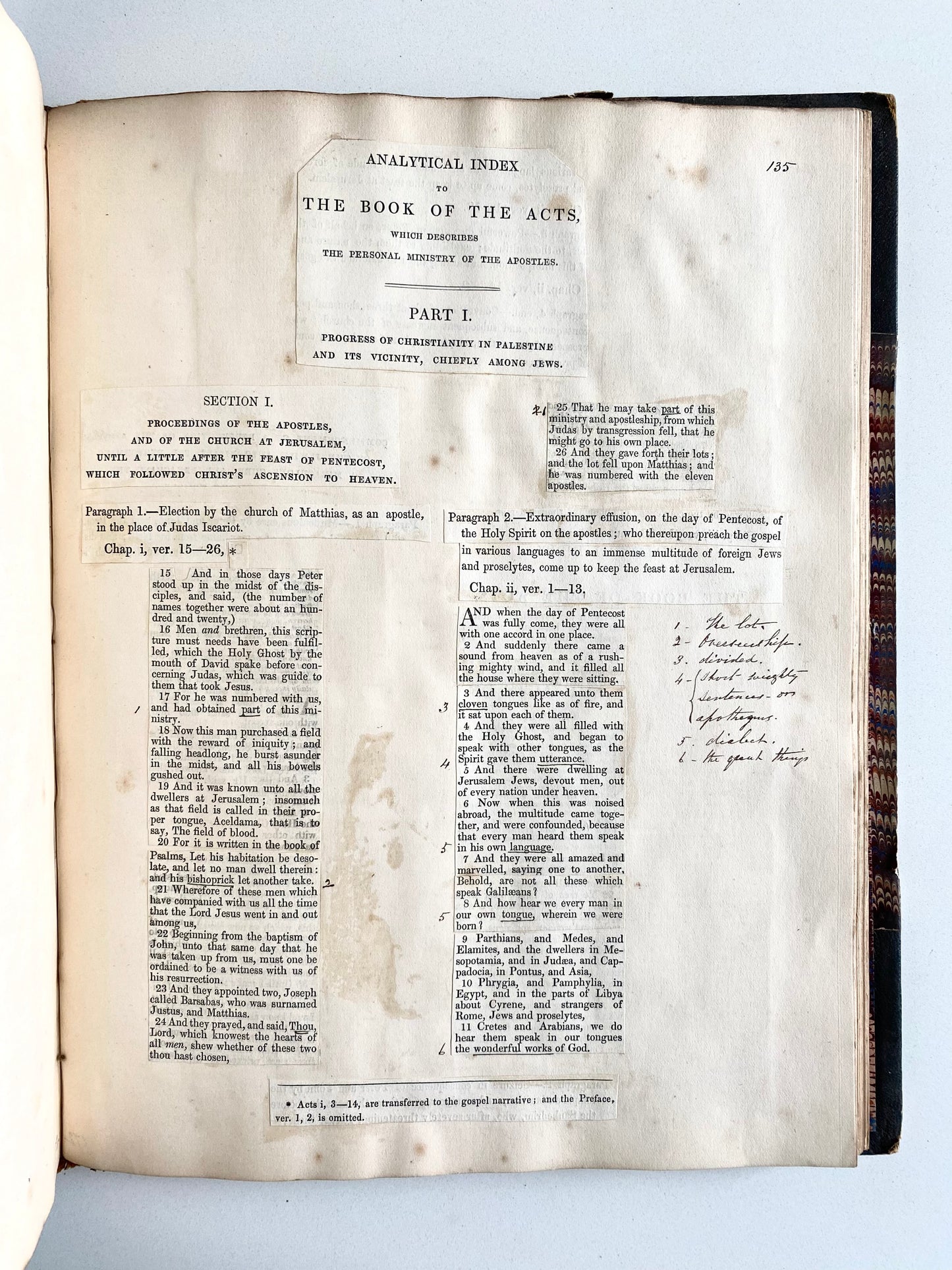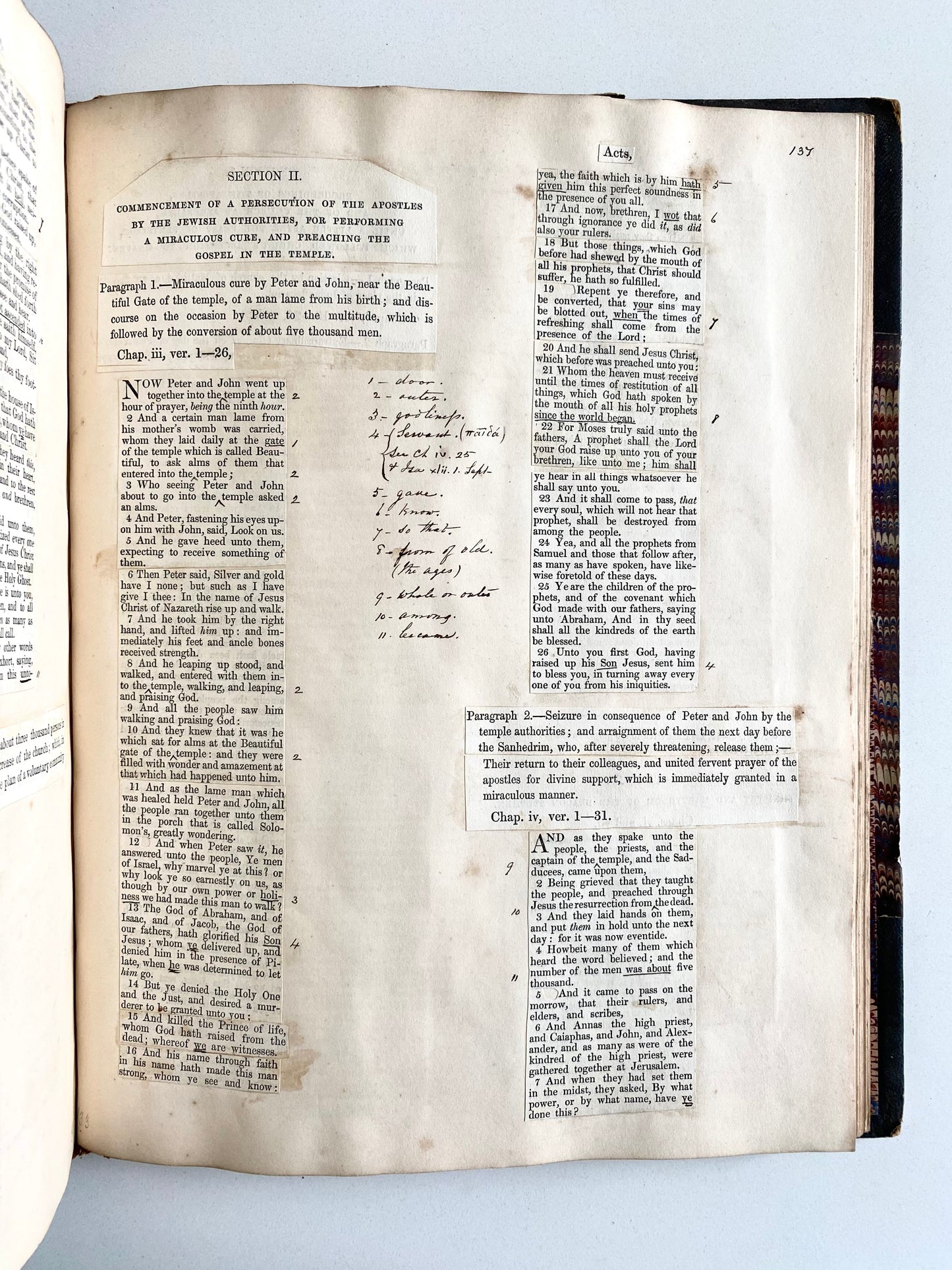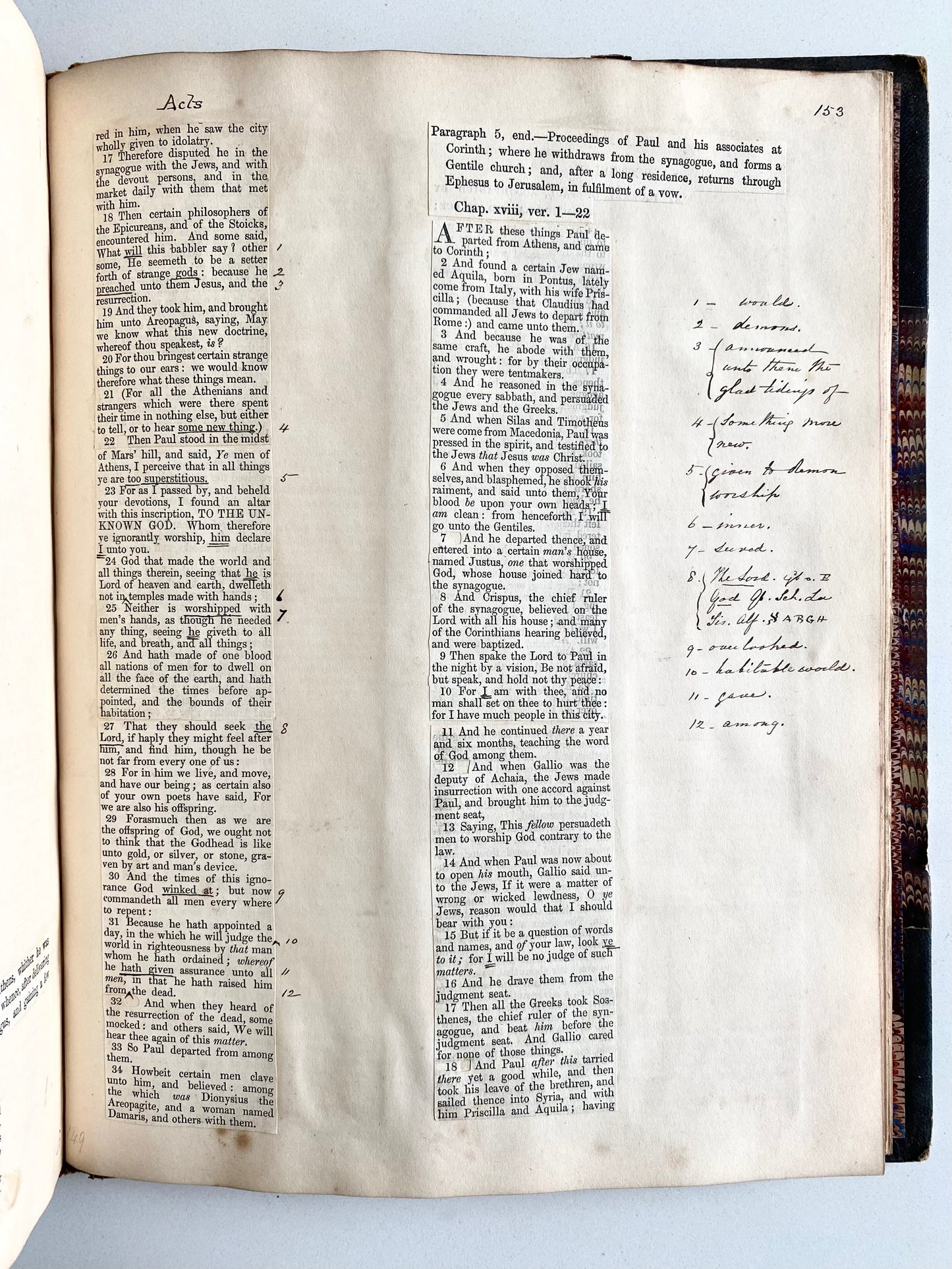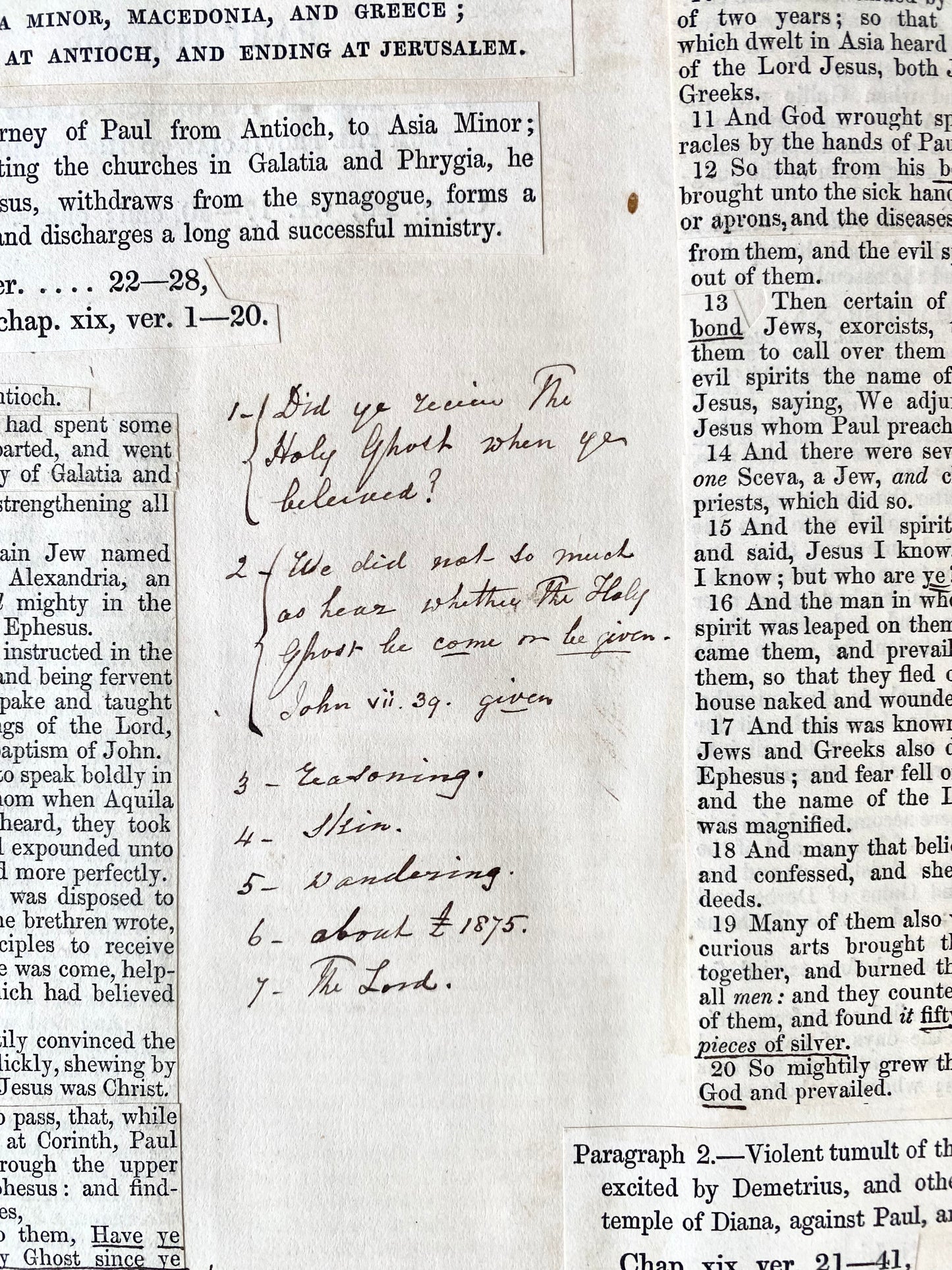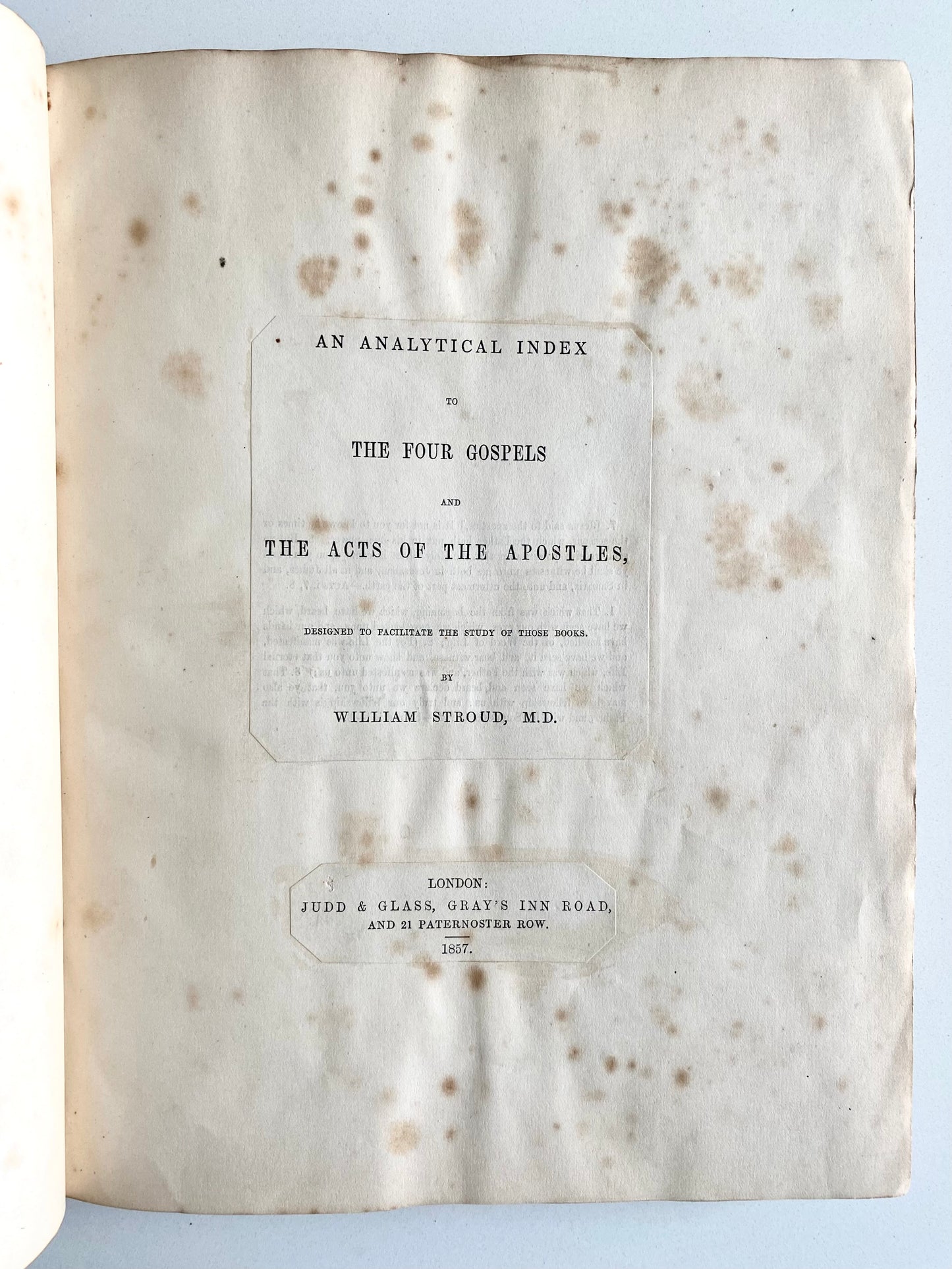Specs Fine Books
1857 EUNICE BAGSTER. Important MSs Critical Translation of Gospels & Acts by Pioneer Female Commentator!
1857 EUNICE BAGSTER. Important MSs Critical Translation of Gospels & Acts by Pioneer Female Commentator!
Couldn't load pickup availability
An important 1857 original critical translation and commentary based around William Stroud’s Analytical Index to the Four Gospels and the Acts of the Apostles, itself quite rare. And, scarcely, compiled and commented on by an important early female Biblical scholar, Eunice Bagster [1804-1878].
Eunice was the daughter of famed Bible publisher, Samuel Bagster [1772-1851] and her mother of the same name, who lived to the ripe old age of 100. Samuel was educated under the Baptist divine, John Ryland and took up the publishing trade early in life.
He had worked for the bookseller William Otteridge for some time, and was disheartened to see the significant cost of Polyglot Bibles and other resources. The prohibitive costs of production rendered the informed study of Scripture out of the reach of most average people. He had found his place. He formed his company and immediately set to work. Because of the laws in England, only the two major Universities could print the Bible, but the law did not apply to Bibles with notes or marginalia or in the original languages. So his first projects were the Hebrew Bible and a Septuagint. The loophole also made the Polyglot viable, and in 1816 he produced what a cost-effective Polyglot in an inexpensive foolscrap binding.
It was a raving success. He was right. People wanted greater access to tools to help them read Scripture well. He nearly started another Reformation. Tyndale and Luther and company may have given the Bible to the people, but Bagster gave them the tools to read it!
In addition to bringing good tools to the masses, he used that success to advance on two further fronts; first, underwriting new academic works, often in beautiful, high quality and exotic bindings known for their beauty and durability, i.e. seal, etc., and second, printing or the missionary field. The Bagster motto became, “The inhabitants of earth have many tongues, those of heaven have but one.”
And Bagster’s passion for Scripture did not stay at the office. His family was known for their engaged and dynamic family worship and study of Scripture. . . little Eunice among them, one of twelve. In fact, one of the most important devotional guides of the 19th century was developed as the fruit of their family devotional activity* [see the account below].
Eunice clearly picked up the passion for Christ, for Scripture, and for the work the family had been called to at a young age. She never married and gave herself wholly to the family business, reading and studying Scripture, teaching others about Scripture, illustrating the family’s publications, and charitable causes.
This work executed c.1857, 1858 is one of the earliest works of true female translation and commentary of which we are aware. The famed translation of Julia Smith, officially the first published translation of Scripture by a female, would not see ink meet paper until 1876.
There exists one other similar volume sold some time ago at auction, i.e., a 222pp manuscript with similarly excised printed texts on the prophets and her handwritten notes on the interpretation of Biblical prophecy throughout. The confidence she demonstrates in her abilities as an able reader of Scripture are evident in that volume’s opening lines: “Let us imagine the Bible open before us, and beginning at Genesis we will trace the stream of prophecy from the Garden of Eden to the close of Revelation.” That is am ambitious undertaking indeed.
Not only was she an early female biblical scholar worthy of further academic research, but she was a pioneer in another area, illustration. She was a skilled artist and created woodcuts, line engravings, and detailed illustrations seemingly for many of Bagster’s publications, including The Pilgrim’s Progress [1845], etc., Her illustrations appear to be all unsigned, but we know of her work thanks to none other than Robert Louis Stevenson. He had been gifted a copy of her illustrated edition of Pilgrim’s Progress as a boy by his parents. Later in life, he wanted to track down the illustrator of the little drawings that formed such an important part of his childhood, and he at least learned that they were all done by Bagster’s own daughter. Again, it would be worthy of further research to locate her exact contribution to the publishing legacy of Samuel Bagster and Sons.
The present volume is a large quarto, bound up of 185 blank pages and contains the work of Stroud excised and arranged with the Gospels collated together and then her critical translation notes, etc,. throughout. There is barely a page without some translation suggestion in her hand, many of which are technical, interpretive, or suggestive in some way. Others are simple “notes” regarding the process of translation, or meanings, etc. i.e. “I am Gabriel” in Luke 1.19 gets a side note of “Heb. Strong one of God.”
She begins right at the beginning of Luke, which she seems to give priority, suggesting “official ministers” for “ministers in Luke 1.2, the past tense “have been” rather than “are” in Luke 1.1. She prefers Jehovah to “the Lord,” includes notes on the original Hebrew words, Greek passages actually written in Greek.
On the whole, she seems to deeply favor translations that provide a clear reference point backward toward the Old Testament text. She prefers Christ of Jehovah to Lord’s Christ [Luke 1.26], the heavens to heaven [reflecting a Jewish cosmology], Rabbi to teacher or master, and “lampstand of the world” rather than “light of the world” to evoke the connection to the Tabernacle and the Temple, and the Anointed or Messiah to Christ as it more directly calls into mind the prophetic and messianic place of Jesus in the plan of the Father, and instead of “from God only” she prefers the Deuteronomy 6.4 reminiscent, “from the only God,” etc.
Her reading as a female is also deeply evidenced. Gendered words are frequently underlined, special attention given to translations effecting females, i.e. handmaidens of Jehovah, seemingly connecting the women of the Gospels back to the influential women of the Old Testament. In light of role as a single woman working in the Kingdom, this may have been of special importance to her. She also looks to the gendered translations of passages like Acts 9.7, “but seeing no man,” and notes it would be better “no one.”
Comments are also focused on demonology, angelology, and “invisible world” and eschatology. She rightly prefers demons to devils, Gehenna fire to hell, as already mentioned “the heavens” for heaven, etc.,
Stroud, William. An Analytical Index to the Four Gospels and the Acts of the Apostles, Designed to Facilitate the Study of those Books. London. Judd & Glass. 1857.
Excised and laid in as described and shown, including the critical introduction. The work itself scarce with no copies on the market. Obviously, this copy completely unique.
Large quarto, foxed, very solid and clean generally, though the binding is rubbed and the front board detached. Worthy of preservation and research.
Also includes a fine little autograph letter [1872] to Eunice Bagster from Thomas Barnardo for the Bagster family's assistance with the East End Juvenile Mission, on the Mission's letterhead, in very fine state, and signed by Barnardo.
.
.
.
*The origin of Daily Light on the Daily Path is closely connected with the Bagster family of England and the publishing firm which bore the same name—Samuel Bagster & Sons Limited.
Samuel Bagster was born in England, December 26, 1772, and brought up in the nurture and admonition of the Lord in a Christian home.
At age 7, he was enrolled in a school taught by the Baptist minister John Ryland, and at the close of his education Samuel was indentured to a bookseller. Upon completion of his apprenticeship, he opened his own bookshop in London, April 19, 1794, at the age of twenty-one. A devout Christian, he made it a rule that he would never sell any book which might be considered questionable in taste or subject.
Samuel Bagster married Eunice Birch, December 19, 1797 and they were blessed with twelve children. It was Jonathan (1813-1872), their tenth child, who was mainly responsible for the idea and the method by which Daily Light was compiled when he was himself a husband and father.
In preparing for daily family worship, Jonathan Bagster selected a Scripture text that the family joined together in prayer were asked to illustrate by further applicable Scripture texts. He was editor-in-chief, and his daughter Anne was his chief assistant.
The resultant Scripture texts "were carefully considered, discussed and arranged by common consent of all those present, after which the manuscript would be laid aside for prayer and meditation to see if there would be any guidance for further improvement. Sometimes it was weeks before it was felt that the reading for a particular day could not be improved and then that page would be sent to the printer to be set in type. Later it would be read and corrected and all the references would be verified. Each day for two years the readings were compiled, corrected and improved in this way until the whole book was ready for publication in two volumes, one of the Morning readings and the other of the Evening readings."
It was one of Jonathan's sons, Robert (1847-1924), who in about 1875, first published the collection of 732 Scripture readings—morning and evening for 366 days.
According to Robert Bagster—"This book was prepared entirely within our family, mostly by my father, Jonathan Bagster, his sister, and eldest daughter, while others of the younger ones (myself included), worked in a subordinate position. Few can appreciate the heart-searching care with which every text was selected, the days, nay weeks, of change, alterations, and improvements, until at last each page was passed."
Thus it is correct to say that Daily Light on the Daily Path was prepared by Jonathan Bagster and other members of his family, who were descendants of Samuel Bagster (1772-1851), founder of the publishing firm, Samuel Bagster & Sons Ltd. in 1794. [wholesomewords.org]
Share
